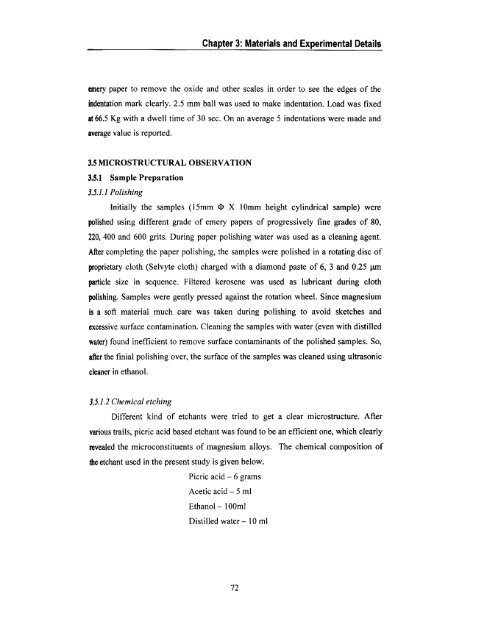“Influence of Si, Sb and Sr Additions on the Microstructure ...
“Influence of Si, Sb and Sr Additions on the Microstructure ...
“Influence of Si, Sb and Sr Additions on the Microstructure ...
You also want an ePaper? Increase the reach of your titles
YUMPU automatically turns print PDFs into web optimized ePapers that Google loves.
f W _ _ Chapter 3g:lVlaterials <str<strong>on</strong>g>and</str<strong>on</strong>g> Experimental Details<br />
emery paper to remove <strong>the</strong> oxide <str<strong>on</strong>g>and</str<strong>on</strong>g> o<strong>the</strong>r scales in order to see <strong>the</strong> edges <str<strong>on</strong>g>of</str<strong>on</strong>g> <strong>the</strong><br />
indentati<strong>on</strong> mark clearly. 2.5 mm ball was used to make indentati<strong>on</strong>. Load was fixed<br />
at 66.5 Kg with a dwell time <str<strong>on</strong>g>of</str<strong>on</strong>g> 30 sec. On an average 5 indentati<strong>on</strong>s were made <str<strong>on</strong>g>and</str<strong>on</strong>g><br />
average value is reported.<br />
3.5 MICROSTRUCTURAL OBSERVATION<br />
3.5.1 Sample Preparati<strong>on</strong><br />
3.5.1.1 Polishing<br />
Initially <strong>the</strong> samples (l5mm (D X 10mm height cylindrical sample) were<br />
polished using different grade <str<strong>on</strong>g>of</str<strong>on</strong>g> emery papers <str<strong>on</strong>g>of</str<strong>on</strong>g> progressively fine grades <str<strong>on</strong>g>of</str<strong>on</strong>g> 80,<br />
220, 400 <str<strong>on</strong>g>and</str<strong>on</strong>g> 600 grits. During paper polishing water was used as a cleaning agent.<br />
After completing <strong>the</strong> paper polishing, <strong>the</strong> samples were polished in a rotating disc <str<strong>on</strong>g>of</str<strong>on</strong>g><br />
proprietary cloth (Selvyte cloth) charged with a diam<strong>on</strong>d paste <str<strong>on</strong>g>of</str<strong>on</strong>g> 6, 3 <str<strong>on</strong>g>and</str<strong>on</strong>g> 0.25 pm<br />
particle size in sequence. Filtered kerosene was used as lubricant during cloth<br />
polishing. Samples were gently pressed against <strong>the</strong> rotati<strong>on</strong> wheel. <str<strong>on</strong>g>Si</str<strong>on</strong>g>nce magnesium<br />
is a s<str<strong>on</strong>g>of</str<strong>on</strong>g>t material much care was taken during polishing to avoid sketches <str<strong>on</strong>g>and</str<strong>on</strong>g><br />
excessive surface c<strong>on</strong>taminati<strong>on</strong>. Cleaning <strong>the</strong> samples with water (even with distilled<br />
water) found inefficient to remove surface c<strong>on</strong>taminants <str<strong>on</strong>g>of</str<strong>on</strong>g> <strong>the</strong> polished samples. So,<br />
after <strong>the</strong> finial polishing over, <strong>the</strong> surface <str<strong>on</strong>g>of</str<strong>on</strong>g> <strong>the</strong> samples was cleaned using ultras<strong>on</strong>ic<br />
cleaner in ethanol.<br />
3.5.1.2 Chemical etching<br />
Different kind <str<strong>on</strong>g>of</str<strong>on</strong>g> etchants were tried to get a clear microstructure. After<br />
various trails, picric acid based etchant was found to be an efficient <strong>on</strong>e, which clearly<br />
revealed <strong>the</strong> microc<strong>on</strong>stituents <str<strong>on</strong>g>of</str<strong>on</strong>g> magnesium alloys. The chemical compositi<strong>on</strong> <str<strong>on</strong>g>of</str<strong>on</strong>g><br />
<strong>the</strong> etchant used in <strong>the</strong> present study is given below.<br />
Picric acid - 6 grams<br />
Acetic acid — 5 ml<br />
Ethanol — 100ml<br />
Distilled water — 10 ml<br />
72
















